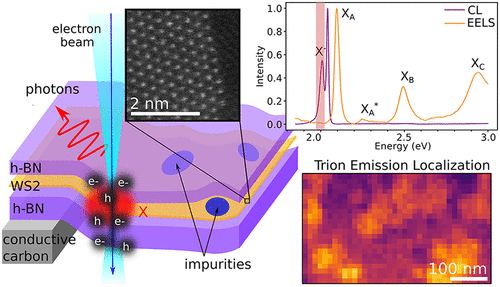Structural, electronic, and chemical nanoscale modifications of transition metal dichalcogenide monolayers alter their optical properties. A key missing element for complete control is a direct spatial correlation of optical response to nanoscale modifications due to the large gap in spatial resolution between optical spectroscopy and nanometer-resolved techniques. Here, we bridge this gap by obtaining nanometer-resolved optical properties using electron spectroscopy at cryogenic temperatures, specifically electron energy loss spectroscopy for absorption and cathodoluminescence for emission, which are then directly correlated to chemical and structural information. In an h-BN/WS2/h-BN heterostructure, we observe local modulation of the trion (X–) emission due to tens of nanometer wide dielectric patches. Trion emission also increases in regions where charge accumulation occurs, close to the carbon film supporting the heterostructures. The localized exciton emission (L) detected here is not correlated to strain above 1%, suggesting point defects might be involved in their formation.
Nanoscale Modification of WS2 Trion Emission by Its Local Electromagnetic Environment

Bonnet, N., Lee, H. Y., Shao, F., Woo, S. Y., Blazit, J.-D., Watanabe, K., Taniguchi, T., Zobelli, A., Stéphan, O., Kociak, M., Gradečak, S., & Tizei, L. H. G. (2021). Nanoscale Modification of WS 2 Trion Emission by Its Local Electromagnetic Environment. Nano Letters, 21(24), 10178–10185. https://doi.org/10.1021/acs.nanolett.1c02600
